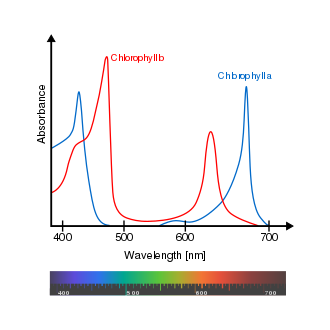Not as you might think
Is it Chlorophyll?
Why are plants green? This is a classic question that even children start asking very early in their life. I believe it being a common question, with a pretty commonly known answer:
Plants are green because their cells contain chloroplasts, and each chloroplast contains many copies of a molecule called chlorophyll, essential for photosynthesis.
But is it wrong?? Not really, it’s just missing a couple of details.

Check out this graph that shows how chlorophyll absorbs pretty much nothing in the green space of the visible spectrum, in fact it reflects it. Vice versa Chlorophyll absorb very well red and blue wavelengths, meaning that all the colors different from the green wavelengths get “trapped” in the leaves and only the green light can bounce off and reach our eyes, thus appearing to us green indeed.
Many other colors
It’s important to notice that many vegetal cells, can contain many other molecules each of which can actually have different colors. Flavonoids, carotenoids, tannins, alkaloids and many other compounds contributes to make up all the colors within a plant, from the trunk to the flower. These compounds are usually stored in the vacuole, a large aqueous organelle, or into other organelles called plastids, namely the famous chloroplasts in which we find the chlorophyll. Actually many of these pigments are of very different colors, like red and orange! But wait! If plant cells contain many other colored pigments, why are they green? Well it turns out that for most organisms that do, appear green, chlorophyll simply takes over and overwhelms the other colors. That is actually the reason why in autumn, leaves of many trees turn orange and brown instead of staying green: because chlorophyll gets degraded and leaves space to the other colors to become much more visible.
The real question
Very interesting, but this is still not the question that I wanted to answer. The real astounding question would be: “Why is chlorophyll green?”
Evolved to absorb light
Ok, so does this question even make sense? Well, as we mentioned before, if an object appears to us colored, it means that some part of the light spectrum is reflected by that object surface and the reflected waves bounce to our eyes. In fact, if you can see a red rose, is because the petals absorb every wave but the red ones. Some materials are just like that, and they appear like they appear because of their physical structure and composition. It doesn’t mean that the surface “needs” to absorb those specific colors.
Chlorophyll however, is a compound shaped by natural evolution to absorb light to kick start photosynthesis where a water molecule is broken into oxygen and the energy is used to fixate CO2 into sugars.
So, why is Chlorophyll green?
It’s all ancients bacteria’s fault!
One fascinating hypothesis is that before modern chlorophyll-based photosynthesis evolved, a different form rose in the depths of waters in purple bacteria or archaea that absorbed much of the green light that was not only very abundant but also excellent to penetrate the deepest layers of the oceans. But this of course, left the competitors photosynthesizers with no choice to take the rest of available light, meaning blue and red, reflecting green. For some reasons it seems that most of these purple bacteria have gone extinct, somehow leaving green alternative much more common in the modern world.
How much light?
So for having photosynthesis we need absorption of light, but how much of it? Different wavelengths of light have different energy and it’s established that 2 photons in the visible spectrum are absorbed for each water molecule. It’s hard to estimate how much actual energy is needed to drive photosynthesis, but it’s rational to assume that if 2 photons in the visible range are enough, then 1 UV photon could do the job as well (double the energy). However, we have to consider that UV radiation is decently filtered out by our atmosphere so it’s not as abundant as visible light. This means that after all, visible light in the blue and red spectra are good enough for what the photosynthesis demands are there is no reason to think that evolution would push for a change.
That’s just how it happened!
On the other hand, it makes sense to assume that chlorophyll and photosynthesis in general are so complex and finely-tuned that it’s very difficult to change even a small part of the whole process. So it could simply be, that chlorophyll from its ancestor molecules “ended up” being green, as much as it could have “ended up” being blue or yellow. And any of these colors would have possibly done the job!
We don’t need to optimize!
We have also to consider that there’s no need for optimization! The sun releases on Earth so much energy in form of electromagnetic waves that the limiting factor is not actually how much light we have, but what to do with it. So there is no reason for the process to be more optimized since even the absorption of a very small fractions of all the available photons, would be perfectly enough for the process to evolve and sustain the cells.
In principle to make photosynthesis as efficient as possible, we would think that the more light is absorbed the more sugar can be produced. So in principle black plants would be able to absorb much more light than green plants, but it would in return open up a whole new problem that green plants don’t have to deal with: over-heating! So after all, absorbing only a fraction of the spectrum is not that bad after all right?
By the way, some black plants (more like grass) really exists!! Try googling it! Pretty cool huh? Let me tell you another story…

Leave a comment